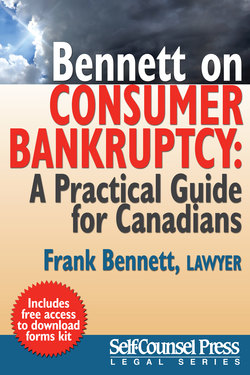Читать книгу Bennett on Consumer Bankruptcy - Frank Bennett - Страница 32
На сайте Литреса книга снята с продажи.
5. Apply to the Court for a Discharge
ОглавлениеThe bankruptcy of an individual person operates as an application for discharge. If the bankrupt is a first-time bankrupt, then there is an automatic discharge nine months after filing unless the bankrupt has refused or neglected to receive counselling or where a creditor, the trustee, or the Superintendent objects to the discharge, or where the bankrupt has no surplus income. If there is opposition, there is a special hearing before the bankruptcy registrar or judge. For individuals who have been bankrupt before, or in circumstances where their conduct is questionable, the discharge could take much longer.
While the consumer debtor is undischarged, that is while the consumer debtor is still in bankruptcy, the consumer debtor’s surplus wages, salary, or commission, or a draw as a self-employed individual, are subject to seizure or attachment by the trustee for the benefit of creditors. The amount that the trustee is entitled to attach depends on the debtor’s family income, family responsibilities, and personal situation. On filing the bankruptcy papers, the trustee must review the consumer debtor’s surplus income requirement and determine according to the Superintendent’s Standards what portion the debtor is going to pay to the estate while the debtor is undischarged. Annually, the Superintendent’s office publishes these standards in chart form setting out suggested payments depending upon the size of income and the number of dependents. The standards are the same across Canada and do not take into account regional disparities of income and expenses; see Appendix III.
At the discharge hearing, creditors may oppose the consumer debtor’s discharge if they have reason to believe that the debtor’s conduct prior to and during the bankruptcy was improper under certain prescribed provisions of the Bankruptcy and Insolvency Act. When the consumer debtor gets out of bankruptcy all the proceedings stop and the consumer debtor is free to enter into business and obtain credit once again.
In Chapter 14, there is a review of the discharge hearing and what a consumer debtor can expect at the hearing.
Figure 3 shows the bankruptcy process.
